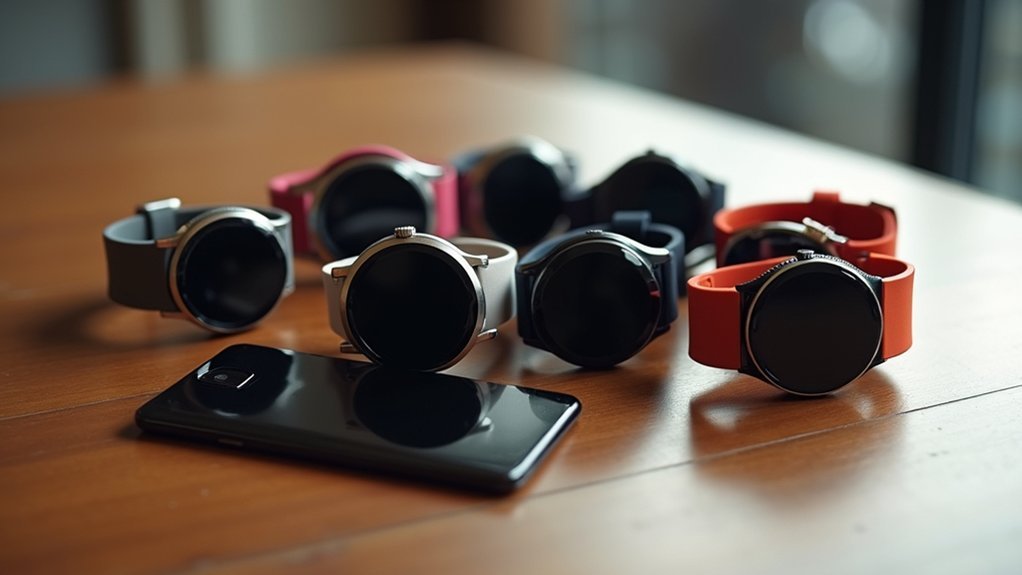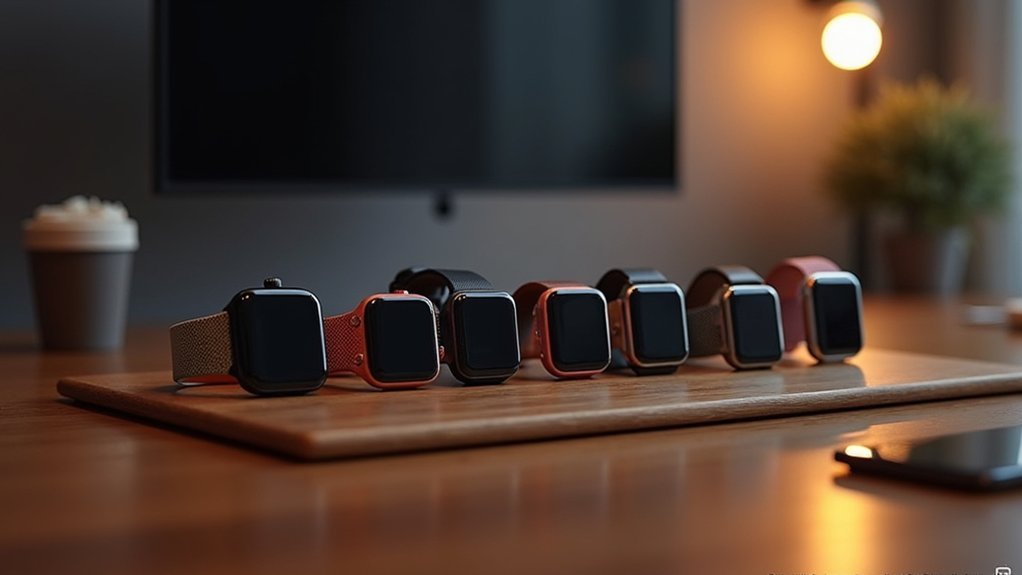You’ve invested in a Garmin watch for your fitness journey, but are you capturing the most accurate heart rate data possible? Wrist-based measurements can fall short during intense workouts, which is why chest straps remain the gold standard for serious athletes.
From female-focused designs like the HRM-Fit to swimming-specific options like the HRM-Swim Premium, the right chest monitor can transform your training insights. Let’s explore which heart rate strap will best complement your Garmin and elevate your performance.
1. Garmin HRM-Fit
Female athletes seeking accurate heart rate data without the discomfort of traditional chest straps will find the Garmin HRM-Fit a welcome innovation. This women-specific monitor clips directly onto medium and high-support sports bras, eliminating the need for separate straps.
With a year-long battery life, it reliably transmits real-time heart rate data to your Garmin devices while capturing advanced running metrics like stride length and ground contact time. It even tracks daily activity stats including steps and calories.
Though some users report bulkiness during floor exercises, many appreciate its ease of use and improved comfort compared to conventional monitors.
Best For: Female athletes who want accurate heart rate monitoring without the discomfort of traditional chest straps, particularly those who regularly use Garmin devices for tracking workouts and daily activities.
Pros:
- Clips directly onto medium and high-support sports bras, eliminating the need for separate chest straps
- Captures advanced running metrics like stride length and ground contact time to help improve form
- Long battery life of up to one year with seamless connectivity to Garmin devices
Cons:
- Bulky design may be uncomfortable during floor exercises like yoga or core workouts
- Not compatible with certain bra styles (longline, front-zip, or light-support bras)
- Higher price point compared to other heart rate monitors on the market
2. HRM-Swim
Serious swimmers seeking accurate heart rate data during aquatic workouts will find the HRM-Swim an essential training companion. This specialized blue strap uses ANT technology and Bluetooth to transmit real-time metrics to your Garmin device.
What sets the HRM-Swim apart is its ability to store your heart rate data during swimming sessions and automatically sync once you’re back on land. The non-slip nylon strap stays securely in place during dives and flip turns.
Beyond heart rate, it captures advanced swimming dynamics to improve your technique. Available since April 2024, it comes with a one-year warranty.
Pros:
- Stores and syncs heart rate data after swimming sessions, allowing for comprehensive post-workout analysis
- Non-slip nylon strap design ensures the monitor stays in place during intense swimming activities including dives and flip turns
- Provides advanced swimming dynamics metrics beyond just heart rate to help improve technique and performance
Cons:
- Only available since April 2024, making it a relatively new product with limited long-term user feedback
- Specialized for swimming, which may limit versatility for multi-sport athletes seeking a single heart rate monitor
- Higher price point compared to standard heart rate monitors due to its specialized swimming-specific features
3. Polar H10
Athletes demanding clinical-grade accuracy will find the Polar H10 Heart Rate Monitor to be an exceptional choice. This chest strap delivers impressive precision: 92.9% for running, 99.3% for cycling, and 95.3% for weight training.
You’ll appreciate its versatile connectivity through Bluetooth, ANT+, and 5kHz GymLink, allowing simultaneous connections to multiple devices including your Garmin watch. The comfortable pro strap features improved electrodes and silicone dots to prevent slipping during intense workouts.
With 400-hour battery life and internal memory for one training session, the H10 works effectively even underwater. It’s available in XS/S and M/XXL sizes.
Pros:
- Exceptional accuracy across different activities with 99.3% accuracy for cycling and over 92% for running and weight training
- Versatile connectivity with Bluetooth, ANT+, and 5kHz GymLink allowing simultaneous connections to multiple devices
- Comfortable, slip-resistant design with improved electrodes and silicone dots, plus impressive 400-hour battery life
Cons:
- Some users report intermittent connectivity issues and pairing difficulties with the Flow app
- Customer service can be slow to respond with limited support options
- Higher price point compared to basic heart rate monitors with fewer features
4. Polar T31
The Polar T31 offers a reliable heart rate monitoring solution for fitness enthusiasts seeking accurate data without interference. Its individually coded transmission prevents crosstalk with nearby devices during your workouts.
Compatible with various Polar monitors (FT1, FT2, FT4, FT7, etc.) and gym equipment, this waterproof transmitter fits chests from 25 to 54 inches. You’ll need to moisten the electrodes before use and verify the Polar logo sits upright.
While the 2500-hour battery isn’t user-replaceable, the T31’s durability makes it ideal for all weather conditions. After workouts, rinse with water and store in a cool, dry place.
Best For: Fitness enthusiasts who need reliable, interference-free heart rate monitoring during workouts at gyms or outdoors and who use compatible Polar heart rate monitors or gym equipment.
Pros:
- Individually coded transmission prevents interference from nearby heart rate monitors in crowded gym settings
- Waterproof design makes it versatile for all weather conditions and water-based activities
- Compatible with a wide range of Polar heart rate monitors and most gym equipment with built-in receivers
Cons:
- Battery is not user-replaceable, requiring purchase of a new transmitter when battery dies
- Requires moistening of electrodes before each use for reliable readings
- Some users report intermittent heart rate readings, especially when the transmitter isn’t sufficiently moist
5. Garmin HRM 200
Fitness enthusiasts seeking reliable heart rate tracking without breaking the bank will find the Garmin HRM 200 Heart Rate Monitor an excellent investment. This monitor delivers accurate real-time heart rate and HRV data while seamlessly connecting with Garmin devices and fitness apps.
You’ll appreciate the comfortable, adjustable strap that comes in two sizes (XS-S and M-XL) for an ideal fit. Maintenance is hassle-free with the machine-washable strap—just remove the module before washing.
With a year-long battery life, 3 ATM water rating, and stellar 4.4-star customer rating, this lightweight 2.2-ounce monitor offers dependable performance for all your workout needs.
Best For: Fitness enthusiasts who want an affordable, accurate heart rate monitor that’s compatible with Garmin devices and offers hassle-free maintenance.
Pros:
- Provides accurate real-time heart rate and HRV data with seamless device compatibility
- Features a comfortable, machine-washable strap available in two sizes for optimal fit
- Long battery life (up to 1 year) with user-replaceable CR2032 battery
Cons:
- Module must be removed before washing the strap
- Limited to 3 ATM water rating which may not be suitable for swimming
- May require periodic reconnection with some devices based on customer feedback
6. Garmin HRM Pro Plus
Serious endurance athletes seeking premium heart rate monitoring need search no further than the Garmin HRM Pro Plus. This advanced chest strap delivers exceptional accuracy while tracking extensive metrics including running dynamics, vertical oscillation, and ground contact time.
You’ll appreciate its dual ANT+/Bluetooth connectivity and ability to store workout data when your watch isn’t nearby—like during swimming. It automatically syncs with your Garmin device afterward.
The HRM Pro Plus also tracks daily activity metrics and seamlessly integrates with the Garmin ecosystem. At 51 grams with a replaceable battery, it’s a worthwhile investment despite the premium price tag, as confirmed by its impressive 4.7/5 customer rating.
Best For: Dedicated endurance athletes and fitness enthusiasts who prioritize accurate heart rate tracking, comprehensive running metrics, and seamless integration with the Garmin ecosystem.
Pros:
- Exceptional accuracy with dual ANT+/Bluetooth connectivity for real-time heart rate monitoring across multiple devices
- Stores workout data during activities out of range (like swimming) and automatically syncs with compatible Garmin devices
- Provides advanced metrics including running dynamics, stride length, and vertical oscillation data for comprehensive training insights
Cons:
- Premium price point compared to basic heart rate monitors on the market
- Not machine washable due to the fixed monitoring electronics in the strap
- Requires a compatible Garmin device to fully utilize all advanced features and metrics
7. Garmin HRM-PRO
Dedicated athletes seeking extensive performance metrics will find the Garmin HRM-PRO an essential training companion. This premium chest strap transmits real-time heart rate data via both ANT+ and Bluetooth, ensuring seamless connectivity with your Garmin watch and third-party apps like Zwift.
You’ll get extensive running dynamics including vertical oscillation, ground contact time, and stride length. It even stores heart rate data during swims when your watch can’t receive signals underwater. With a year-long battery life and impressive water resistance, the HRM-PRO handles intense workouts without issue. Though some users report shorter battery life after heavy use, most praise its comfort, accuracy, and reliability.
Best For: Serious athletes and runners who want comprehensive performance data including advanced running metrics, heart rate monitoring during swimming, and seamless integration with Garmin devices and third-party fitness apps.
Pros:
- Dual ANT+ and Bluetooth connectivity enables reliable data transmission to Garmin watches, fitness equipment, and apps like Zwift
- Captures advanced running dynamics (vertical oscillation, ground contact time, stride length) to help improve running form
- Stores workout data independently during swimming when watch connectivity isn’t possible underwater
Cons:
- Some users report shorter than expected battery life with heavy use despite the advertised one-year lifespan
- Requires careful handling during battery replacement to avoid potential damage
- Data recording can be inconsistent when not paired in real-time with a compatible device
Factors to Consider When Choosing Heart Rate Chest Straps & Monitors That Work With Garmin Watches
When selecting the right heart rate monitor for your Garmin watch, you’ll need to evaluate several key factors that impact performance and compatibility. Consider connectivity options (ANT+, Bluetooth), battery life specifications, design features tailored to your specific activities, and appropriate water resistance ratings for your training environment. These critical elements will determine whether your heart rate monitor delivers reliable data during intense workouts or casual fitness tracking sessions.
Connectivity Technology Options
Understanding connectivity technology options greatly impacts your experience with Garmin-compatible heart rate monitors. Most quality monitors utilize Bluetooth Low Energy for direct connection to your Garmin device, enabling real-time data transmission during workouts.
Look for monitors with ANT+ technology if you need simultaneous connections to multiple devices—this versatility proves valuable for complex training setups. Consider that some models store heart rate data when out of range and automatically sync once you’re back in proximity to your Garmin.
Dual transmission features allow sharing data between your Garmin watch and third-party fitness apps, expanding your tracking capabilities. If you use various fitness equipment, make certain your chosen monitor’s connectivity technologies support integration with your entire workout ecosystem for seamless performance tracking.
Battery Life Duration
Battery life represents a key factor that greatly impacts your satisfaction with Garmin-compatible heart rate monitors. When selecting a device, look for models offering up to one year of operation before requiring a battery change. The type of battery—often CR2032 in chest straps—affects both longevity and replacement convenience.
You’ll notice that advanced features like continuous data transmission to your Garmin watch will drain power faster. Regular maintenance, including cleaning contacts and proper storage, can extend battery performance greatly. Many users report diminished battery life after exposure to sweat and water, so consider water resistance ratings if you’re training in challenging conditions.
Remember that manufacturer estimates often reflect ideal usage scenarios, so expect slightly shorter real-world performance depending on your training frequency and environmental conditions.
Activity-Specific Design Features
When you plunge into the world of heart rate monitors for your Garmin watch, the activity you primarily engage in should drive your purchase decision. Different monitors excel in specific environments and collect data most relevant to your sport.
For swimmers, look for monitors that track swimming dynamics and store data underwater, syncing with your Garmin once you’re back on dry land. Runners benefit from monitors measuring vertical oscillation, ground contact time, and stride length to refine technique.
Comfort matters regardless of your activity. You’ll find options with adjustable straps or clip-on designs that accommodate various body types and sports bras. If you’re tackling extreme conditions, prioritize waterproof designs and durable materials that withstand high-intensity workouts or challenging environments.
Water Resistance Rating
Anyone who’s experienced the frustration of a device failing mid-workout due to moisture knows the importance of water resistance ratings. When selecting a heart rate monitor compatible with your Garmin watch, pay close attention to the IP rating – higher numbers indicate better protection against water damage.
For swimmers, you’ll need a chest strap specifically designed for aquatic activities with ratings that support full immersion. These waterproof monitors continue to capture accurate heart rate data even underwater, without signal interruption.
Remember that water resistance isn’t permanent. To maintain your monitor’s protective capabilities, rinse it after exposure to chlorine or saltwater. This simple maintenance step prevents corrosion and extends the lifespan of your device, ensuring it remains reliable through countless swimming sessions and rainy outdoor workouts.
Data Storage Capabilities
Modern heart rate monitors offer much more than real-time readings, with internal memory that captures your essential statistics even when you’re out of range from your Garmin watch. This guarantees you’ll never lose valuable workout data during activities that take you beyond Bluetooth range.
Look for monitors that automatically sync stored information once you’re back in range, eliminating manual transfers. The best models don’t just track heart rate—they store extensive metrics including steps, calories burned, and intensity minutes in one convenient device.
For serious athletes, consider monitors that record specialized performance data like running dynamics, including vertical oscillation and ground contact time. Battery life directly impacts storage capabilities, so choose models offering up to a year of continuous use for uninterrupted data collection during your training sessions.
Comfort And Fit
Finding the perfect heart rate monitor extends beyond technical specifications, as comfort and fit play essential roles in the accuracy and usability of these devices during workouts.
The Garmin HRM-Fit offers women-specific design with its innovative clip-on system for medium and high-support sports bras, ensuring stability during various activities. For those seeking versatility, the Polar H10 features a soft strap with improved electrodes that prevent slippage while maintaining comfort.
Weight matters during extended sessions—the Garmin HRM Pro Plus weighs only 51 grams with compact dimensions, making it barely noticeable during long runs. The Polar T31 accommodates diverse body types with its 25-54 inch size range.
Before committing, consider that some users find certain models like the Garmin HRM-PRO bulky under clothing, so trying different options is worthwhile.
Running Dynamics Metrics
While comfort guarantees you’ll actually wear your heart rate monitor, serious runners need to contemplate what performance data they can access. Several premium heart rate straps offer advanced running dynamics metrics that can transform your training approach.
These metrics include vertical oscillation (up-and-down movement), ground contact time (foot-to-ground duration), stride length, and vertical ratio. Lower vertical oscillation typically indicates more efficient running form, while shorter ground contact times often correlate with improved speed. Your stride length affects overall efficiency—longer strides generally benefit performance when maintaining proper form. The vertical ratio (oscillation divided by stride length) provides insight into wasted vertical energy—lower is better.
When selecting a chest strap, consider which of these metrics matter most to your training goals and verify compatibility with your Garmin device.
Frequently Asked Questions
Do Heart Rate Monitors Work Accurately for High-Intensity Interval Training?
Heart rate monitors can accurately track your HIIT sessions, but chest straps offer better precision than wrist-based monitors. You’ll get more reliable data when you’re pushing through intense intervals with rapid heart rate changes.
Can I Use Non-Garmin Heart Rate Straps With My Garmin Watch?
Yes, you can use non-Garmin heart rate straps with your Garmin watch. Most third-party straps that use ANT+ or Bluetooth technology will pair seamlessly with your Garmin device, giving you more options and flexibility.
How Long Do the Batteries Typically Last in Chest Strap Monitors?
Chest strap monitor batteries typically last 6-12 months with regular use. You’ll get longer life if you’re disconnecting the pod after workouts. Many models use replaceable CR2032 coin cell batteries for convenience.
Are Chest Straps More Accurate Than Wrist-Based Heart Rate Tracking?
Yes, chest straps are more accurate than wrist-based heart rate tracking. You’ll get more reliable readings because they’re closer to your heart and aren’t affected by movement or skin tone like wrist monitors are.
Can Chest Straps Track Heart Rate Data Without a Connected Watch?
Yes, many chest straps can track heart rate data independently without a connected watch. You’ll find most models store your workout data internally until you sync them with a phone app later.








Leave a Reply